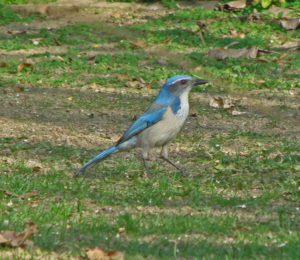We are now faced with a similar identification problem that involves the “Western Scrub-Jay.” Research has indicated that “Western Scrub-Jay” is really two distinct species. This decision impacts those who bird the eastern Sierra Nevada since both newly recognized species are found here. “Western Scrub-Jay” is now either a California Scrub-Jay, Aphelocoma californica, known in the past as the “coastal” form of the “Western Scrub-Jay” or a Woodhouse’s Scrub-Jay, Aphelocoma woodhouseii, known in the past as the “interior form” of the “Western Scrub-Jay.” So now, the next time we observe a scrub-jay, we need to ask “which scrub-jay is this?” Remember, there is no longer a “Western Scrub-Jay.”
The two species are superficially similar and have been reported to interbreed, thus all scrub-jays may not be identifiable in the field. With careful observation and given good views, most individuals should be. And remember, when in doubt, leave it out or enter the old “Western Scrub-Jay,” which indicates that you didn’t see it well enough to be sure which of the two new species it was.
The California Scrub-Jay is found over most of the state and is common on the west slope of the Sierra Nevada. They also occur on the east slope of the Sierra Nevada from the Kern County line north to Division Creek, about 11 miles north of Independence. Division Creek is the northern limit of oak trees on the east slope in our area and this is an important food source for this species. The California Scrub-Jay is also found on the floor of the Owens Valley near the towns of Lone Pine and Independence. This form in unexpected to the east of the Owens Valley in pinyon–juniper woodlands. That said, this does not mean that a wandering bird could not occur. Basing the identification of any bird only on location is not a good idea.
The expected scrub-jay east of the Owens Valley is Woodhouse’s Scrub-Jay. This species is known to wander, particularly during the non-breeding season, late August to late May, when they have been found on the floor of the Owens Valley and Death Valley and near Tecopa. They also have been reported breeding on the east slope of the Sierra Nevada south of Independence. There are many reports of this species, formerly called the “interior form,” on the Bishop Christmas Count.How do we know which scrub-jay we are looking at? We recommend a study of either of the two best field guides used by most serious birders, the National Geographic Society’s The Birds of North America or the Sibley Guide to Birds. Both are excellent books and cover the two new species well. Since this two species split has just occurred, these books will have them labeled as Western Scrub-Jay with a coastal form and an interior form. California Scrub-Jay is much brighter blue dorsally and has a well defined partial breast band on the upper breast. It also has a bright white throat and line above the eye. Ventrally, the bird is paler than the dingy gray of the Woodhouse’s Scrub-Jay. The bill is stouter and more strongly hooked than that of the Woodhouse’s Scrub-Jay, better for opening oak acorns! With the Woodhouse’s Scrub-Jay think “duller, grayer” and more slender-billed, better for prying out pine nuts from the cones. The “duller and grayer” is a trait shared by a number of bird species that occur in the Great Basin versus their genetic congeners who are west of the Sierra Nevada, which are the brighter ones. That is not a political statement! Remember the other rule: When in doubt—photograph it!
Tags: scrub-jay, sparrow


